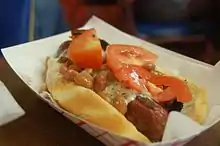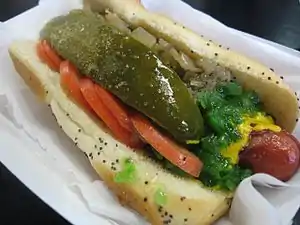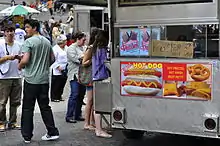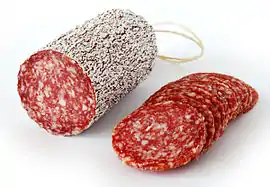Hot dog variations
This is a listing of regional variations on the hot dog. Different areas of the world have local variations on the type of meat used, condiments, and means of preparation, which are enumerated below.

United States
Hot dogs are very popular throughout the United States. Many regional variations exist.[1]
Arizona

The Sonoran hot dog is popular in Tucson, Phoenix, and elsewhere in southern Arizona, as well as in the neighboring Mexican state of Sonora. It is a hot dog wrapped in mesquite-smoked bacon, cooked on a grill or on a griddle or comal,[3] then topped with pinto beans, onions, tomatoes, mayonnaise, mustard and jalapeño salsa or sauce, and served on a bolillo roll, often with a side of fresh-roasted chili pepper. It originated in Hermosillo, the capital of Sonora.[4][5]
California
In Los Angeles, Pink's Hot Dogs promotes its celebrity customers and its chili dogs, the latter of which come in a wide number of varieties.[6] A local chain, Tommy's,[7] also has chili dogs featuring a premium natural casing hot dog alongside its much better-known chili hamburgers, and another local chain The Hat, which specializes in pastrami, has them also.
Other notable Los Angeles chains that specialize in hot dogs include Hot Dog On A Stick, which serves a preparation similar to a corn dog, and Wienerschnitzel, a chain that bills itself as "The World's Largest Hot Dog Chain."[8] The Farmer John Dodger Dog is sold at Dodger Stadium.
Street vendors in Los Angeles also serve the "Downtown Dog" or "LA Street Dog" a Mexican-style bacon-wrapped hot dog with grilled onions, jalapeños, and bell peppers, and mustard, ketchup, and mayonnaise as condiments. These are typically sold around closing time outside nightclubs and bars by street vendors, who grill the hot dogs on small push-carts. The legality of such operations may be questionable, leading locals to sometimes refer to these treats as "Danger Dogs".[9]
Oki Dog, in West Hollywood, or Oki's Dog, on Pico[10] serves the Original Oki Dog—two hot dogs on a flour tortilla, covered with chili and pastrami and wrapped up like a burrito. This is a variation on a hot dog served on the Japanese island of Okinawa, which is where it takes its name.
Connecticut

Connecticut hot dog restaurants often serve sausages produced by local family operations such as Hummel Bros, Martin Rosol, or Grote & Weigel, with national brands being relatively less common. The hot dogs are typically served on New England rolls. There is otherwise no particular Connecticut style though deep frying and homemade condiments are common. [11]
District of Columbia
A half-smoke is a "local sausage delicacy" found in Washington, D.C. and the surrounding region. Similar to a hot dog, but usually larger, spicier, and with more coarsely-ground meat, the sausage is often half-pork and half-beef, smoked, and served with herbs, onion, and chili sauce.
Georgia
In Columbus, Georgia, a local favorite is the "scrambled dog," the exemplar of which was first served at the Dinglewood Pharmacy by "The Lieutenant" Charles Stevens over 50 years ago. The scrambled dog is a chopped hot dog covered by chili, onions and pickles with an accompanying portion of oyster crackers.[12]
In Fitzgerald, Georgia, Johnnie's Drive In served the "scrambled dog" beginning in the early 1940s. Johnnie's scrambled dog is two sliced hot dogs over a hot dog bun with mustard and catsup and covered with oyster crackers, chili, cole slaw, and sliced dill pickles.[13]
Illinois

The Chicago-style hot dog is a steamed kosher-style all-beef, natural-casing hot dog on a steamed poppy seed bun, topped with yellow mustard, chopped white onions, a dill pickle spear, tomato slices, Chicago-style relish, hot sport peppers, and a dash of celery salt.[14] Chicago-style hot dogs do not include ketchup.
This "dragged through the garden" style (more commonly called, "with the works"), is heavily promoted by Vienna Beef and Red Hot Chicago, the two most prominent Chicago hot dog manufacturers,[15] but exceptions are common, with vendors adding cucumbers or lettuce, omitting poppy seeds or celery salt, or using plain relish or a skinless hot dog.[16] Several popular hot dog stands serve a simpler version: a steamed natural-casing dog with only mustard, onions, plain relish and sport peppers, wrapped up with hand-cut fries, while the historic Superdawg drive-ins notably substitute a pickled tomato.
Kansas and Missouri
A Kansas City-style hot dog is a pork sausage in a sesame seed bun topped with brown mustard, sauerkraut and melted Swiss cheese.[17]
Maine
The most popular variety of hot dog in Maine is made with natural casing. The casing is colored red, and one company refers to their red variety as red snappers.[18]
Massachusetts
In Boston, hot dogs are often served steamed as opposed to grilled. The Fenway Frank, served at Fenway Park, is a fixture for Red Sox fans, and there are several other local brands such as Pearl that are used. Hot dogs in the Boston area are associated with Boston baked beans, though this is not unique to the region. Ketchup, mustard, relish, picalilli, and chopped onions are the most common toppings.[19] The bread is nearly always the top-loading New England-style hot dog bun, which may be toasted, grilled, or steamed.
Michigan
In southeastern Michigan, restaurants serve what's known as a Coney dog, developed early in the 20th century by Greek immigrants. "Coney joints" are very specific as to the ingredients: a beef or beef and pork European-style Vienna sausage of German origin in a natural lamb or sheep casing, topped with a spiced sauce made with ground beef heart, one or two stripes of yellow mustard and diced or chopped white onions. There are three variations on the Coney dog: Jackson style, which started in 1914 with a ground beef sauce prior to switching to ground beef heart in the early 1940s,[20] Detroit style, first served in 1917 and made with a more soupy beef heart-based sauce, and Flint style, with Flint Coney Island opening in 1924 serving a specially-developed Koegel's coney topped with thicker, meatier sauce based on a Macedonian goulash, made almost entirely of a finely ground beef heart blend from Abbott's Meat.[21] With over 350 chain and independent purveyors of these dogs in the metro-Detroit area alone, an entire restaurant industry has developed from the hot dog and are called Coney Islands.[22] A coney dog is not to be confused with a chili dog, a more generic ground beef-based chili-topped hot dog.
New Jersey
New Jersey's Italian hot dog[23] includes diced fried potatoes combined with brown mustard served on a spicy hot dog. The most common brands of spicy hot dogs used are Sabrett's or Best's, both of which are NJ companies. A traditional Italian Hot Dog is made by cutting a round "pizza bread" in half (for a double) or into quarters (for a single), cutting a pocket into it and spreading the inside with mustard. A deep-fried dog (or two if it is a double) is put in the pocket, topped with fried (or sautéed) onions and peppers, and then topped off with crisp-fried potato chunks. A variation of this, often found at express takeout restaurants (such as "chicken shacks," Chinese restaurants, pizzerias, etc., and can also be requested at some lunch trucks and luncheonettes across the state) substitutes French fries for the traditional potato round, and in some spots a Portuguese or sub roll replaces the traditional round bread used.[24]
Rutt's Hut in Clifton, NJ is famed for its rippers, hot dogs deep-fried to the point where the sausages burst open, resulting in a dense, caramelized outer casing. The rippers are served with Rutt's homemade relish, a blend of mustard, onions, carrots and cabbage.
The Texas wiener was created in Paterson, New Jersey sometime before 1920.[25][26] The "Texas" reference is to the chili sauce used on the dogs, which actually has a stronger Greek influence due to the ethnicity of the cooks who invented it. The wiener, also referred to as an all-the-way dog, consists of a hot dog covered in Düsseldorf mustard (as opposed to the Coney, which uses yellow mustard), diced onions, and chili sauce.
New York

In New York City, the natural-casing all-beef hot dogs served at Katz's Delicatessen, Gray's Papaya, Papaya King, Papaya Dog and any Sabrett cart are all made by Sabrett's parent company, Marathon Enterprises, Inc.. (Levine 2005). Nathan's hot dogs, which are all-beef and come in both natural-casing and skinless, were also made by Marathon until several years ago (Levine 2005). Local kosher brands—which are not permitted natural casings—include Hebrew National, Empire National (Levine 2005). The usual condiments are mustard and sauerkraut, with optional sweet onions in a tomato based sauce invented by Alan Geisler, usually made by Sabrett. Hot dogs are available on street corners as well as at delicatessens. New York street vendors generally store their unsold dogs in warm-water baths, giving rise to the semi-affectionate moniker "dirty water dog." Bagel dogs are also sold in Manhattan.[24]
The white hot or "porker" is a variation on the hot dog found mostly in the Rochester area.[27] It is composed of some combination of uncured and unsmoked pork, beef, and veal; it is believed that the lack of smoking or curing allows the meat to retain a naturally white color.[28] White hots are almost exclusively eaten with mustard, specifically spicy brown, and other spices, and often include a dairy component such as nonfat dry milk.
In the Capital District surrounding Albany, smaller-than-usual wieners are served with a spicy meat sauce; the Capital District style is quite similar to the New York System or Hot Wieners of Rhode Island. In the mid-twentieth century, hot dog purveyors reportedly would carry the dogs to the table lined up on their bare forearms, giving rise to the term "the Hairy Arm";[29] today, health codes prohibit this practice. Further north, in three locations in and around Glens Falls, New Way Lunch has served similar hot dogs with meat sauce, mustard, and raw onions for nearly 100 years.[30]
Buffalo, Rochester and Western New York state are known for charcoal-broiled hot dogs, cooked over real hardwood charcoal. Prominent purveyors include Ted's and Louie's.
Texas hots have a niche following in western New York, where the Rigas family (later of Adelphia Communications infamy) introduced the dish. A 2017 article in the Olean Times Herald made note of the dish's disappearance from the city of Olean.[31]
North Carolina
In North Carolina, hot dogs have a distinct red color and are prepared Carolina style which includes chili, cole slaw and onions; locally, mustard sometimes replaces slaw, or is added as a fourth item. Merritt's Burger House has been serving Carolina hot dogs since 1958.[32]
Ohio
In Cincinnati, a hot dog topped with Cincinnati chili is called a "coney," and when grated cheddar cheese is added, a "cheese coney." The default coney also includes mustard and diced onion.[33]
In Cleveland, a kielbasa or hot dog served on a bun covered with a layer of french fries, a layer of sweet southern style barbecue sauce or hot sauce, and a layer of coleslaw is called a Polish Boy. Variations exist for the preparation of the sausage or hot dog, whether it is grilled or fried. Another Cleveland favorite found at any north-eastern Ohio sporting or entertainment venues, is a hot dog with "Stadium Mustard". Stadium Mustard is a type of Brown mustard with similar flavor to a spicy Dijon mustard.
Toledo is known for Tony Packo's Cafe. Their "Hungarian hot dog" is technically a Hungarian sausage called Kolbász, not unlike the Polish kielbasa, is about twice the diameter of a conventional hot dog, and is sliced in half before being grilled and topped with the restaurant's spicy chili sauce.
 Cheese coneys (Cincinnati)
Cheese coneys (Cincinnati) Polish boy (Cleveland)
Polish boy (Cleveland)
Pennsylvania
There are several variety of local dog recipes in Pennsylvania. In Philadelphia, street vendors sell hot dogs that can be topped with one or more of several traditional Philadelphia toppings: ketchup, mustard (yellow and/or spicy brown), chopped onion (cooked/soft or raw), relish, and (without exception) sauerkraut. In Allentown, Pennsylvania there is regional Yocco's Hot Dogs. Various shops and butchers in Pennsylvania make traditional German natural casing franks. Altoona, Pennsylvania has two remaining Texas Hot Dog stands that claim a legacy going back to 1918.[34] The Texas Tommy was invented in Pottstown, Pennsylvania, and is prepared with bacon and cheese.[35]
Rhode Island
The hot wiener or New York System wiener[36] is a staple of the food culture of Rhode Island.[37][38] It is typically made from a small, thin hot dog made of veal and pork, thus giving it a different taste from a traditional hot dog made of beef. Once placed in a steamed bun, the wiener is topped with a meat sauce seasoned with a myriad of spices like cumin, paprika, chili powder, and allspice, which is itself covered in finely chopped onions, celery salt, and yellow mustard.
Texas
The Houston style hot dog consists of a beef dog on a toasted potato bun, which has been spread with cream cheese. The dog is split lengthwise and filled with curry ketchup. It is topped with special grilled caramelized onions, french-fried onions, honey mayo and sriracha sauce.[39] Other condiments sometimes include spicy mustard and green sauce. The Houston style dog has spread into other cities and can be found in suburbs like Sugarland and as far away as Austin.[40][41]
Washington
In Seattle, hot dogs are served with cream cheese and grilled onions on a toasted bun. The sausages are split in half and grilled before being put in the bun. Stands offer a variety of condiments, such as Sriracha sauce and jalapeños.[42]
Canada
The Whistle Dog is served by some[47] A&W restaurants[48] in Canada. A whistle dog is a hot dog that has been split and served with processed cheese, bacon, and relish.
Montreal
A Montreal-style hot dog, as popularized by numerous shops such as the famous Montreal Pool Room,[49] is either steamed or griddle fried (nicknamed steamies or toasties, respectively). It is generally served topped with coleslaw, onion, and mustard; relish, ketchup, mayonnaise and occasionally paprika or chili powder may be added at a condiment counter by the customer. Due to the bilingual nature of Montreal street culture, these are usually ordered, and condiments named, in Franglais.[50] Montreal hot dogs can be found throughout Eastern Canada and the United States.[51]
Latin America
Brazil
_hot_dog..JPG.webp)
In São Paulo state, some hot dogs consist of a non-heated bun cut in two (across its short section, forming two semi-circular halves) and each half is filled with a Vienna-type sausage, tomato vinaigrette, canned sweet corn, canned peas, ketchup, mustard, mayonnaise, fried shoestring potatoes, and topped with mashed potatoes; served in a plastic bag, which it fills completely, and shaped so that the top layer of mashed potatoes (or optionally grated Parmesan cheese) forms a flat oblong surface.
In the State of Piauí in the Northeast region of Brazil, the hot dog is made from a long and soft bread cut in half. Its flavorings vary in the cafeterias of the region, the most found are: sausage topped with spicy sauce, meat, corn green Lint and slices of melted cheese.[52]
Chile

In Chile, there is a popular variation called completo (Spanish for "complete", "full") which, besides bread and sausages, can be made up of mashed avocado, chopped tomatoes, mayonnaise, sauerkraut, salsa americana, Chilean chili, green sauce and cheese. Its size can be twice that of an American hot dog.[53]
The multiple combinations of the ingredients of the completo leads to have specific names for the most typical ones, for example:
- Completo (Complete): Traditional version with chopped tomatoes, mayonnaise (a large amount) and sauerkraut. In some regions, this variation also has avocado sauce. The term "completo" is also used as the generic name for any hot dog with avocado, this combination is sometimes called "completo completo".
- Dinámico (Dynamic): A mix of the aforementioned ingredients; tomatoes, avocados, mayonnaise and sauerkraut or salsa americana. Also called "américana" (American).
- Italiano (Italian): Consists of chopped tomatoes, mashed avocados and mayonnaise. The name comes from its resemblance to the colors of the Italian flag.
- Tomate mayo (Tomato-mayo): As its name suggests, this version has only chopped tomatoes and mayonnaise. Also called "completo sin palta" (completo without avocado).
- As (Ace): A version which consists of cuts of "churrasco" (grilled meat) instead of sausages, mashed avocado, tomato and mayonnaise. It's a variant version of the "italiano".
Colombia
In Colombia perros calientes are sold in street stands with ketchup, mustard, salsa rosada, mayonnaise, pineapple sauce, cheese and crumbled potato chips. Some add a cooked quail's egg on top. In the coast, it's common to also add some finely shredded lettuce to the bun, giving it a refreshing touch for the coast's hot weather. There is also a version called "perra", it usually has the same other toppings but it's made of chopped bacon and barbecue onions instead of a sausage.
Guatemala
In Guatemala shucos are sold across the country, especially in the country's capital, Guatemala City. Shucos are usually served with guacamole, boiled cabbage, mayonnaise, mustard, and an assorted choice of meats. Chopped onions are added by a decent amount of shuqueros (hot dog vendors) across Guatemala City and Antigua. The most popular choices of meats are sausage, chorizo (red sausage), salami, longaniza (white sausage), and bacon. They are cooked in a charcoal grill and hot sauce is offered at customer's request.[54]
Mexico
In Mexico, often called "dogos" or "jochos", is common to top hot dogs with "Pico de Gallo", ketchup, mustard, mayonnaise and wrapping the sausage with bacon. Other parts of the country may include chips, mushrooms, beef or other ingredients besides the bun and sausage.[55]
The Sonoran-style or Estilo Sonora hot dog, found in Sonora, is a hot dog wrapped in mesquite-smoked bacon then cooked on a grill or on a griddle or comal, then topped with beans, grilled onions, fresh onions, tomatoes, mayonnaise, cream sauce, mustard and jalapeño salsa or sauce and served on bread and often with a side fresh-roasted chili. It originated in Hermosillo, the capital of Sonora.
Africa
South Africa
In South Africa, a variation of the hot dog is found called a "boerie roll" (Afrikaans slang for farmer's roll) or "boerewors roll" (Afrikaans slang for farmer's sausage roll). In this variation, a piece of boerewors, often braaid, is placed in a sliced bread roll. The boerie roll can be covered in tomato sauce (ketchup) or a home made tomato and onion relish.
Asia
Japan
In Japan, hot dogs are used in bento boxes and are often sliced to resemble an octopus. More conventional hot dogs are also available, either on a stick (with or without a coating) or on a bun. Japanese Fusion Dogs, such as those sold at the Vancouver-based chain Japadog, are not actually from Japan but are a Pacific Northwest invention that pairs hot dogs with Japanese and Asian condiments like wasabi, kimchi and teriyaki.[56][57]
Malaysia
In October 2016 the Malaysian Islamic Development Department ruled that hot dog vendors must rename their product or risk not getting halal certification, because in Islam dogs are considered unclean. The Malaysian Tourism and Culture Minister criticized the ruling and said, "Even in Malay it's called hot dog — it's been around for so many years. I'm a Muslim and I'm not offended."[58]
Philippines

In the Philippines, hot dogs are eaten as is, in a bun with an optional selection of condiments, or with rice and condiments. Hot dogs are also typically served during breakfast. They are also skewered and grilled over coals, and sold as street food. Skewered waffle hot dogs are also available in the country (a local variant having the hot dogs coated in hotcake batter and then deep-fried). Chopped hot dogs are an ingredient in Filipino spaghetti. They are also used in various other dishes (e.g. as a filling in an embutido, as sliced pieces of meat in tomato-based savories such as caldereta or menudo, etc.).[59][60][61][62][63][64]
South Korea
A popular South Korean form of the hot dog, sold at street stalls, fairs, and some fast-food restaurants, involves the placing of the sausage on a stick, followed by a batter of some kind, and sometimes including french fries in the batter. They more resemble a corn dog than a hot dog. Ketchup is a common condiment, and occasionally mustard. Hot dogs in a bun or wrapped in bread are also widely available, or on a stick without a bun.[65]
Taiwan
Taiwanese style hot dogs are put on a bun or without a bun on a stick.[66] In night markets, meat sausages are sometimes wrapped with an outer sticky rice sausage in a snack called small sausage in large sausage.
Thailand

Hot dogs (Thai: ฮอตดอก; RTGS: hotdok; IPA: [hɔ́t dɔ̀ːk]) are very popular in Thailand and are also used in various ways in Thai cuisine. It can be sold inside a bun similar to a standard American hot dog[67] but instead of tomato ketchup, they are also often eaten with a sweet tomato-chili sauce. Very popular are street vendors selling hot dogs which have been deep-fried or charcoal grilled. They are served with either a sweet, slightly spicy sauce (nam chim wan) or a very spicy sauce (nam chim phet). Hot dogs can also be used as a filling for a croissant which are served with mayonnaise. Hot dogs are even used as a filling for raisin bread together with shredded dried pork.[68][69][70][71][72] The Thai dish called khao phat Amerikan or American fried rice, rice fried with tomato ketchup and containing raisins, is always served with hot dogs and a fried egg.[73] Donut sai krok is the Thai name for a sausage filled savoury donut in the shape of a log.[72] Hot dog sausages also feature as an ingredient, together with onion, celery or coriander (cilantro) leaves, lime juice, fish sauce and chili peppers, for a Thai salad called yam hot dok. Another dish that uses hot dogs is called khanom Tokiao (lit. 'Tokyo cake'). This is a Thai style crêpe which is wrapped around a filling of hot dog and sweet chili sauce. The chili sauce can also be served on the side.[74][75][76][77]
Oceania
New Zealand
In New Zealand, the term "hot-dog" refers to a battered deep fried saveloy or sausage on a stick served with tomato sauce. The "American" hot dog is a combination of frankfurter and bun, generally with condiments such as ketchup and mustard, but sometimes served with additional toppings such as fried onion or shredded cheese. Smaller cocktail-sized frankfurters, known as chipolatas, are also common. These are especially popular at birthday parties for young children.
Europe
Czech Republic

Hot dogs in the Czech Republic are known as párek v rohlíku which can be literally translated as sausage in roll with the label hot dog also applied in marketing to both locals and tourists. Czech-style hot dogs are differentiated by the fact that rather than slicing the bun in half and placing the sausage into the resultant cleavage, the top of the bun (rohlík) is cut off, with a hole punched into the softer inside of the bun where condiments and then the sausage is placed, similar to the Ketwurst. Specially designed appliances (stroj na párek v rohlíku[78] - literally appliance for sausage in bun) which consist of a hot-water cooker for the sausages and heated metal spikes to punch the holes and pre-warm the buns also exist to assist vendors with preparation of this dish.
Denmark
One of the most popular Nordic variation is the Danish hot dog. It usually includes a red sausage (Røde Pølser), ketchup, Danish mustard, fried onion, raw onion and sometimes remoulade, a mayonnaise-based sauce with sweet relish and topped with sliced dill cucumbers. But the customer is free to order hot dogs with or without almost anything.
The standard danish hot dog also comes in a variety with a somewhat larger frankfurter sausage, or other kinds of sausages.
Another popular variety of hot dogs in Denmark is the "french hot dog", a cut baguette impaled on a spike with a sausage inside and commonly served with a "french hot dog dressing", a mayo-like sauce containing Dijon Mustard, but otherwise resembling the german Ketwurst - but has been around longer than the Ketwurst has. These are very easy to eat and popular among commuters and families with kids.
The Danish style hot dog has spread to the other Scandinavian countries as well as Germany. Steff Houlberg/Tulip corporation operates 4300 hot dog stands in Denmark alone, and has also opened a chain in Korea, Japan, and China.[79]

 Red sausages (røde pølser)
Red sausages (røde pølser)
Iceland

The Iceland Monitor writes that "locals, expatriates and holiday-makers alike must all be familiar with Iceland’s national dish – hot-dogs with all the trimmings (‘pylsa með öllu’ in Icelandic). The hot-dog sausage is served in bread and liberally accompanied with fried onion, raw onion, mustard, ketchup and remoulade (a cold sauce made with mayonnaise and various condiments and herbs). This delicious snack is traditionally washed down with copious amounts of Coca-Cola."[80]
In August 2006, the British newspaper The Guardian selected Iceland's Bæjarins beztu as the best hot dog stand in Europe.[81] Bæjarins beztu pylsur (English: The best hot dog in town) often shortened to simply "Bæjarins beztu," is a popular hot dog stand in central Reykjavík, Iceland. Hot dogs from this stand are derived from the Danish hot dog. They are often ordered with "the works," i.e., all condiments, or in Icelandic "eina með öllu". Icelandic hot dogs are made from native Icelandic lamb, and served with a mix of raw white and fried onion, ketchup, sweet brown mustard, and a mayonnaise and herb sauce called remoulade.[82][83]
Norway
In Norway, sausages are most often served in white buns, or in a traditional lompe.[84] The sausages are grilled or warmed in hot water, and they are normally served with ketchup or mustard. An alternative condiment to the sausages may be potato salad.[85]
Poland
In Poland, hot dog began to spread in the 1980s. Because of notorious problems with the supply of sausages, the so-called "hot dog with mushrooms" also known as "bun with a stuffing" has been introduced. This type of "hot dogs" could be bought in the second half of the 1980s in almost every major city in Poland. Real hot dogs (with sausage) appeared in Poland along with the political change. The "French Hot Dog" variation is also very popular in Poland.
Sweden
In Sweden hot dogs are served in a bread and topped with mustard and ketchup, additional toppings include roasted onion, shrimp salad, bostongurka or mashed potatoes, the latter goes by the name of "Halv Special" (half special). "Varmkorv med bröd" (hot dog with bread) is widely sold all over Sweden at most street corners from stands and in kiosks and fast food restaurants.[86]
The "French Hot Dog" variation as in Denmark, the Czech Republic and Poland, is also very popular in Sweden, typically served with ketchup, mustard and a garlic mayonnaise sauce.
A very popular swedish variation is the "Tunnbrödsrulle" made out of unleavened flatbread called tunnbröd (literally "thinbread") in a roll. It mostly contains hot dogs with mashed potatoes, lettuce and sliced pickles
United Kingdom
Genuine 'hot dogs' in the American style are very popular in US-themed restaurants, amusement parks and in particular, at cinemas, and one can even find specialist 'gourmet' hot dog and champagne establishments in cities such as London.[87] Frankfurters and hot dog rolls (buns) are widely available in supermarkets for home preparation.
See also
References
- Heil, Meredith (June 27, 2016). "The 41 Most Important Hot Dog Styles in America" Archived September 14, 2016, at the Wayback Machine, Thrillist. Retrieved July 26, 2016.
- D'oro, Rachel Reindeer dogs from Anchorage's cranky hot dog vendor Archived August 9, 2014, at the Wayback Machine Miami Herald 7/26/2014
- Caroline Russock (2010-06-08). "Cook the Book: Sonoran Hot Dogs | Serious Eats : Recipes". Serious Eats. Archived from the original on 2014-02-02. Retrieved 2014-01-27.
- Robbins, Ted. "The Sonoran Hotdog [sic] Crosses The Border". NPR. Archived from the original on 2018-04-05. Retrieved 2009-08-10.
- John T. Edge, "In Praise of the All-American Mexican Hot Dog" Archived October 20, 2016, at the Wayback Machine, New York Times, August 26, 2009.
- "Pinks Hot Dogs". Pinkshollywood.com. Archived from the original on 2008-12-24. Retrieved 2008-12-01.
- "Original Tommy's - Our Story". Originaltommys.com. Archived from the original on October 11, 2007. Retrieved 2008-12-01.
- "HDOS Enterprises, An Employee Owned Company". Hotdogonastick.com. Archived from the original on 2010-02-09. Retrieved 2008-12-01.
- Hernandez, Daniel (2008-02-06). "The Bacon-Wrapped Hot Dog: So Good It's Illegal | Dining | Los Angeles | Los Angeles News and Events". LA Weekly. Archived from the original on 2014-02-02. Retrieved 2014-01-27.
- "Oki-Dog Fairfax Vs. Oki's-Dog Pico: The Chart That No-One Wants To See". Losanjealous.com. 2006-02-28. Archived from the original on 2009-05-19. Retrieved 2009-06-10.
- "Archived copy". Archived from the original on 2019-02-01. Retrieved 2019-01-31.CS1 maint: archived copy as title (link)
- "Nation's Best Hot Dogs -- on a Budget!". CBS News. CBS News. 5 September 2009. Archived from the original on 12 June 2013. Retrieved 26 June 2012.
- "Archived copy". Archived from the original on 2016-10-27. Retrieved 2016-09-30.CS1 maint: archived copy as title (link)
- Zeldes, Leah A. (2010-07-07). "Eat this! The Chicago hot dog, born in the Great Depression". Dining Chicago. Chicago's Restaurant & Entertainment Guide, Inc. Archived from the original on 2013-02-11. Retrieved 2010-07-31.
- Zeldes, Leah A. (June 21, 2011). "Hot dog makers around town". Chicago Sun-Times. Archived from the original on December 2, 2013. Retrieved 2012-07-17.
- Zeldes, Leah A. (June 21, 2011). "Even without trimmings, Chicago-style hot dog in league of its own". Chicago Sun-Times. Archived from the original on December 2, 2013. Retrieved 2012-07-17.
- (Jakle & Sculle 1999:165)
- "Boston.com / News / Local / Maine / Longtime hot dog competitors team up". Archived from the original on 29 January 2005. Retrieved 14 March 2015.
- "A home run, a hot dog, and a hallelujah moment at Fenway - The Boston Globe". Boston.com. September 4, 2005. Archived from the original on 2009-02-11. Retrieved 2008-12-01.
- Flory, Brad. "Brad Flory column: Feeding Jackson's astonishing appetite for ground beef heart". MLive.com. Archived from the original on 26 February 2015. Retrieved 27 January 2015.
- Florine, Bob; Davison, Matt; Jaeger, Sally, Two To Go: A Short History of Flint's Coney Island Restaurants, 2007, Genesee County Historical Society
- "American Coney Island". Americanconeyisland.com. Archived from the original on 2008-12-01. Retrieved 2008-12-01.
- Krall, Hawk (July 2010). "Hot Dog of the Week: New Jersey Italian Hot Dog". Serious Eats. Archived from the original on October 13, 2017. Retrieved October 13, 2017.
- Levine, Ed (May 25, 2005). "It's All in How the Dog Is Served". New York Times. Archived from the original on August 30, 2011. Retrieved 2011-01-21.
- Mercuri, Becky (2007). The Great American Hot Dog Book: Recipes and Side Dishes from Across America. Gibbs Smith. p. 16. ISBN 978-1-4236-0022-0. Archived from the original on 2014-06-28. Retrieved 2016-09-23.
- Stern, Jane and Michael (2002). Roadfood. Broadway Books. p. 98. ISBN 0-7679-0809-0. Archived from the original on 2017-02-17. Retrieved 2016-09-23.
- Evelyn Bence (May 24, 2006). "Red or Whit". The Washington Post. Archived from the original on April 8, 2017. Retrieved August 31, 2017.
- "Hot Dogs As America - Baseball As America - American Museum of Natural History". Archived from the original on 16 July 2012. Retrieved 14 March 2015.
- "Hot Dog of the Week: Mini Dogs from Troy, New York". seriouseats.com. Archived from the original on 6 March 2015. Retrieved 14 March 2015.
- "New Way Lunch". lakegeorgeguide.com. Archived from the original on 9 May 2015. Retrieved 14 March 2015.
- State & Union. Whither the Texas hot? Archived 2017-08-17 at the Wayback Machine Olean Times Herald.
- "Go back in time at Merritt's Burger House: Star News Online". Archived from the original on 2012-04-26. Retrieved 2011-07-26.
- "Cincinnati Chili: Pass the Tabasco". Fodor's. Archived from the original on 2012-02-29. Retrieved 2009-08-19.
- Hawk Krall (Aug 26, 2011). "Hot Dog of the Week: Texas Weiners in Altoona, PA". Serious Eats. Archived from the original on April 19, 2014. Retrieved March 23, 2014.
- Hillibish, Jim (November 10, 2009). "Easy recipe: Texas Tommy". Milford Daily News. Archived from the original on January 15, 2016. Retrieved November 22, 2015.
- Brooks, Anthony. "You Say 'Hot Dogs,' Rhode Islanders Say 'Weenies'" Archived April 24, 2016, at the Wayback Machine. NPR. June 4, 2010.
- Yonan, Joe. "Don't call it a hot dog." The Boston Globe. August 6, 2006.
- "Olneyville New York System". Quahog.org. 2010-07-02. Archived from the original on 2013-12-17. Retrieved 2014-01-27.
- Knapp, Gwendolyn (2017-09-21). "Houston's Best Late Night: Braving the Line for YoYo's Hot Dog". Houston Press. Retrieved 2020-10-19.
- Marshall, Beth (2019-06-27). "True Dog Houston offers halal-friendly food in Sugar Land". impact. Retrieved 2020-10-19.
- Odam, Matthew. "25 places to eat hot dogs in Austin". Austin 360. Retrieved 2020-10-19.
- Hawk Krall (2009-10-02). "Hot Dog Of The Week: Seattle Style". Seriouseats.com. Archived from the original on 2014-04-19. Retrieved 2014-04-18.
- Lundy, Ronni (March 12, 2015). "The Art of Bun, Chili + Slaw, West Virginia Style" Archived August 15, 2016, at the Wayback Machine, The Local Palate. Retrieved July 16, 2016. "Even more telling is the nature of the chili on each. This is not your mama’s bowl chili with chunks of meat and arguable accouterments like beans, tomatoes, peppers and, Lord help us, sometimes spaghetti. Chili Bun Chili is a finely grained aggregate of ground beef, spices and something to make it all hold together in the bun."
- Krall, Hawk (October 26, 2012). "Take a Hot Dog Tour of West Virginia" Archived October 26, 2016, at the Wayback Machine, Serious Eats. Retrieved July 16, 2016.
- McElhinny, Brad. "Earl Ray Tomblin and the WV Hot Dog Hubbub" Archived September 14, 2016, at the Wayback Machine, WVPubcast.org via Storify. Retrieved July 16, 2016.
- "What Is a West Virginia Hot Dog?" Archived December 8, 2016, at the Wayback Machine The West Virginia Hot Dog Blog. Retrieved July 16, 2016.
- DesignGirl (September 21, 2011). "A&W: Whistle Dog (Yes, they serve hot dogs)". Foodology.ca. Archived from the original on 7 January 2012. Retrieved 13 June 2012.
- "Whistle Dog®". www.aw.ca. Archived from the original on 21 September 2011. Retrieved 13 June 2012.
- Kinik, A.J. (2007-05-24). "Sprucing up the hot dog". Montreal Mirror. Archived from the original on 2012-06-30. Retrieved 16 August 2011.
- "Best stimmés/steamies". Archived from the original on 26 August 2012. Retrieved 16 August 2011.
- ""Out Of This World Hot Dogs" Menu". Archived from the original on 30 March 2012. Retrieved 16 August 2011.
- "Hot Dog Central - CACHORROS-QUENTES - COMIDINHAS - VEJA Campinas". VEJA Comer & Beber. Archived from the original on 5 October 2011. Retrieved 14 March 2015.
- Robyn Lee (2008-05-02). "Chilean hot dog and sandwiches". Seriouseats.com. Archived from the original on 2014-03-28. Retrieved 2014-04-18.
- "The Guatemalan Shuco Hot Dog". Antigua Daily Photo. 2009-02-13. Archived from the original on 2014-02-19. Retrieved 2014-01-27.
- Killick, Colin (2011-01-11). "Everything Tasty: Sonoran Hot Dogs -something *positive* from my home town". Everything-tasty.blogspot.nl. Archived from the original on 2014-02-01. Retrieved 2014-01-27.
- "Domo Dogs". Foodcartsportland.com. 2010-05-06. Archived from the original on 2014-04-19. Retrieved 2014-04-18.
- "Japanese Hot Dogs". eatingwithyourhands.com. 2016-05-09. Archived from the original on 2016-08-14. Retrieved 2016-07-25.
- "Hot Dogs 'Must Be Renamed' in Malaysia, Says Religious Government Body". BBC. October 19, 2016. Archived from the original on October 19, 2016. Retrieved October 20, 2016.
- arnold (2009-03-18). "Filipino Spaghetti". Inuyaki.com. Archived from the original on 2013-11-10. Retrieved 2014-01-27.
- "Cooking and Capturing: Filipino's Beef Stew (Kaldereta)". Mashia-freshcook.blogspot.nl. 2010-05-10. Archived from the original on 2013-11-10. Retrieved 2014-01-27.
- "Embutido: Filipino-Style Meatloaf - Burnt Lumpia: Filipino Food | Filipino Recipes | Culinary Hijinks". Burntlumpia.typepad.com. 2009-05-12. Archived from the original on 2013-11-10. Retrieved 2014-01-27.
- "Adventures on making WAFFLE DOGS…". Busog! Sarap!. 2010-02-25. Archived from the original on 2014-01-23. Retrieved 2014-01-27.
- "Hot Dogs in the Philippines". Roadfood.com. Archived from the original on 2013-11-10. Retrieved 2014-01-27.
- Robyn Lee (2009-05-26). "Snapshots from South Korea: Fried Things on Sticks". Serious Eats. Archived from the original on 2014-01-15. Retrieved 2014-01-27.
- Taiwanese Sausage 香腸 Archived January 6, 2011, at the Wayback Machine
- "7-Eleven (Thailand) - Big Bite Hot Dog". Foodspotting. Archived from the original on 2014-02-01. Retrieved 2014-01-27.
- "Thai Street Vendor Prepares Charcoal Barbequed Snacks, 'Luke Chinping'". ImportFood.com. Archived from the original on 2014-02-02. Retrieved 2014-01-27.
- Kodi. "A 'Farangs' trek through a Culture of Food and the Unknown- Thailand". Kodikassell.blogspot.nl. Archived from the original on 2014-02-01. Retrieved 2014-01-27.
- Kimo, Captain (2011-11-28). "Fried Hot Dogs on Stick from Ban Kruat Thailand". Captainkimo.com. Archived from the original on 2014-03-31. Retrieved 2014-01-27.
- Brock (2011-07-14). "Bangkok's Khlong San Pier | The Thailand blog". Travelfish.org. Archived from the original on 2014-02-01. Retrieved 2014-01-27.
- "Did you know...?". Teach Abroad Thailand Blog | Teach English in Thailand | CIEE: Becky and Ryan. 2011-10-07. Archived from the original on 2016-01-15. Retrieved 2014-01-27.
- Leela (2009-05-08). "American Fried Rice (ข้าวผัดอเมริกัน) and the Dead Sea Scrolls". SheSimmers. Archived from the original on 2014-02-01. Retrieved 2014-01-27.
- "Sausage and Tomato Salad". Real Thai Recipes. Archived from the original on 2013-11-15. Retrieved 2014-01-27.
- Appon (2006-03-21). "Savoury Kanom Tokyo ( Crepe Hot Dog )". Appon's Thai Food Recipes. Archived from the original on 2014-02-03. Retrieved 2014-01-27.
- Lemmens, Camille (2010-12-27). "Food on Wheels; Kanom Tokyo". Camille's Samui Info blog. Archived from the original on 2014-02-01. Retrieved 2014-01-27.
- Kongkiatkul, Moragot (2011-03-24). "5 great stops in Siam Square". CNN Travel. Archived from the original on 2012-05-11. Retrieved 2014-01-27.
- Elektro OK (2013-03-19). "Stroj na párek v rohlíku" [Hotdog machine] (in Czech). Elektrook.cz. Archived from the original on 2014-01-12. Retrieved 2014-01-27.
- "Steffkorea". Archived from the original on 2014-03-02. Retrieved 2014-04-18.(registration required)
- "Hot-dog inflation!". Archived from the original on 2017-02-05. Retrieved 2017-02-03.
- "Selur bestu pylsur í Evrópu" [Sells the best hot dogs in Europe] (in Icelandic). Visir.is. 22 August 2006. Archived from the original on 3 March 2016. Retrieved 2014-01-27.
- "Bæjarins Beztu in English". Bæjarins Beztu Pylsur. Archived from the original on 31 July 2016. Retrieved 1 August 2016.
- "http://www.cntraveler.com/stories/2014-08-21/the-one-dish-to-eat-in-iceland". www.cntraveler.com. Archived from the original on 2015-07-03. Retrieved 2015-07-02. External link in
|title=(help) - "Oslo loves hot dogs". Visit Oslo. Retrieved 16 April 2020.
- "Pølse: Norwegian hot dog". Cheapskate's guide to Oslo. 11 January 2017. Archived from the original on 30 May 2019. Retrieved 16 April 2020.
- "Från konfektyrkiosk till thaikök : kiosker och gatukök i ytterstaden / artikelförfattare: Christina Andersson ..." stockholmskallan.se. Archived from the original on 2 April 2015. Retrieved 14 March 2015.
- Tracey Macleod (2012-09-29). "Bubbledogs, 70 Charlotte Street, London W1 - Reviews - Food & Drink". The Independent. Archived from the original on 2014-04-19. Retrieved 2014-04-18.
Further reading
- Barber, Katherine, ed. (2004). Canadian Oxford Dictionary (2nd. ed.). Toronto: Oxford University Press. ISBN 0-19-541816-6.
- Jakle, John A.; Sculle, Keith A. (1999). Fast Food. Baltimore: The Johns Hopkins University Press. ISBN 0-8018-6109-8..
- Levine, Ed (2005-05-25). "It's All in How the Dog Is Served". The New York Times..
- Lindlar, Charlie (April 11, 2012). "Pizza Hut To Pioneer New Hot Dog-Stuffed Crust In UK Branches". Huffington Post (United Kingdom). Retrieved August 3, 2012.

